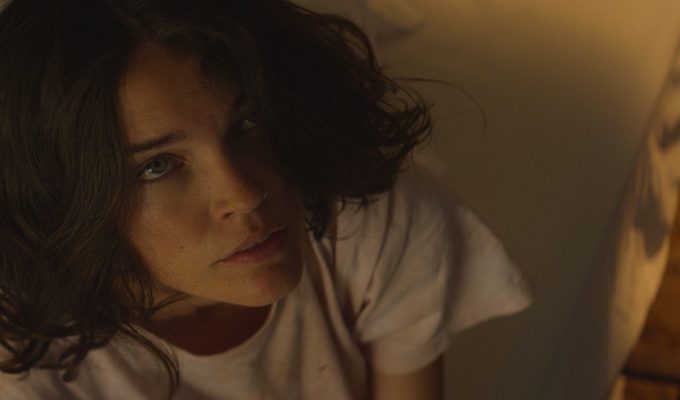 A Madonna in a flimsy oversized t-shirt emerges from the desert. Though her headscarf is a towel, and she sports red cowboy boots on her feet and a thousand-yard ice blue gaze, there’s an undeniable familiarity to this image of the Virgin Mary. In her feature debut “Ma,” star/writer/director/choreographer Celia Rowlson-Hall has crafted a truly unique film. Coupling one of the oldest stories with innovative and fresh filmmaking, Rowlson-Hall utilizes familiar iconography, sound design, and choreographed movement to create a silent film that is anything but quiet. The combination of surreal tone, strange characters, sun-drenched cinematography, and entirely visual movement-based language creates a heady and spellbinding cinematic experience.
A Madonna in a flimsy oversized t-shirt emerges from the desert. Though her headscarf is a towel, and she sports red cowboy boots on her feet and a thousand-yard ice blue gaze, there’s an undeniable familiarity to this image of the Virgin Mary. In her feature debut “Ma,” star/writer/director/choreographer Celia Rowlson-Hall has crafted a truly unique film. Coupling one of the oldest stories with innovative and fresh filmmaking, Rowlson-Hall utilizes familiar iconography, sound design, and choreographed movement to create a silent film that is anything but quiet. The combination of surreal tone, strange characters, sun-drenched cinematography, and entirely visual movement-based language creates a heady and spellbinding cinematic experience.
The story itself is a play on a classic—boy meets girl. In this case, boy meets girl when she wordlessly climbs atop the windshield of his car in the middle of the desert. The boy is Daniel (Andrew Pastides), and the girl is Ma (Rowlson-Hall), but names don’t really matter. He squires her to a low-rent strip motel where she stays for the evening. Amy Seimetz plays a menacing sort of receptionist, and during the night, Ma is visited by a group of mysterious men, dressed in various masculine stereotypes—soldier, priest, cop, cowboy—like a mashup of the three wise men and the Village People. What transpires is a hallucinatory suggested rape, though the wounds and bruises she sports the next day are all too real.

Ma seeks solace with Daniel in the motel, and the two connect through playful gestures and impressions. Slowly, they start to resemble each other, in a uniform of pristine, white, men’s underthings. But it can’t last. The menacing receptionist seems to summon the group of men, infiltrating Daniel and separating him from Ma. She has to undergo a transformation of sorts, taking on a masculine presentation in order to make her journey through the desert to a bright and beautiful feminine utopia. This Ma is both Joseph and Mary in the Biblical metaphor.
In fact, the entire film is a metaphor, the larger overarching story about Madonna and child, with other, smaller symbols enacted throughout the film. Though Ma is the Madonna, she also seems to be the queen of the desert. A burning tumbleweed heralds her arrival. Sand pours through holes in the wall in the motel and from between the legs of a pregnant woman. Children play in the sand. Lying at the bottom of the pool, Ma absorbs every drop. While she is the desert, Daniel is water. Focus is paid to his morning ablutions, shaving, washing, drinking. He weeps out his water and she drinks it in.

As a director, Rowlson-Hall works strong, graphic compositions and slow camera movements— lateral pans, and zooms in and out of the striking images. There’s also a meticulous sound design—as the film is silent, with no dialogue, every motion has its appropriate sound, and the soundtrack is often layered with haunting, nearly human, non-verbal sounds. The look of the film has a love for the aesthetic of timeless Americana: dingy motels, classic cars, and the manifest destiny of the West that grinds to a halt in the desert.
As a choreographer, Rowlson-Hall devises a language of movement through which the characters communicate, deftly using repeated, quotidian gestures. Again and again Ma pulls her arms inside of her ubiquitous t-shirt, turtling inside its flimsy shell, covering up her vulnerability. There are moments that speak to the physicality of gender performance, as Ma stuffs her bra and writhes sexily, or energetically begins her masculine phase with an aggressive and violent outburst. It must be said that Rowlson-Hall is a remarkable physical performer, seeming to defy gravity, and other laws of nature and society.
“Ma” looks and feels decidedly different than anything else, a highly specific vision that embraces the surreal and the mystical alike. Rowlson-Hall isn’t afraid to make a piece about motherhood that embraces both the feminine and masculine in all of its complications within a single person. Its metaphors are open to audience interpretation, using iconographic imagery to delve into the subconscious and rearrange expectations. Illuminating and fiercely original, if you’re willing to go along on a silent, experimental, dance-based journey of a mother in the desert, “Ma” is well worth the ride. [B+]

